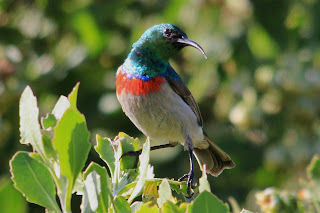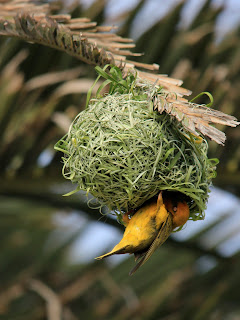Friday 23 September 2011
Who Are You Looking At?
We spent three days looking for elephants in Kariega Game Reserve in Eastern Cape, South Africa.
The reserve covers 9,000 hectares of pristine African wilderness - that's about 35 square miles - so there's plenty of space and bush for even 25 elephants to hide themselves.
So day one: distant views.
But day two: extreme close-ups. So close that they could have pinched the binoculars from round our necks with their trunks if they'd wanted to.
And close enough for one of the young bulls to brandish his tusks in a distinctly intimidating fashion.
Staring down an elephant? Not on your nelly. The open-top Landcruiser was thrown into reverse.
Thursday 22 September 2011
Why I’m Running The Royal Parks Half Marathon For Sky Rainforest Rescue
 |
| Mo Farah pips me in Portsmouth |
Mo Farah just pipped me in the Great South Run in Portsmouth in 2009. I completed the ten miles a mere 32 minutes behind the new 5000m World Champion. I had him worried, though.
The future looked bright when I bagged a couple of sub-1:43 charity half marathons in the following months.
And then mystery ankle-knack, which baffled the finest medics available under the Sky insurance scheme, sidelined me for the season.
I lost my mojo. And it took the plight of the jaguar to help me find it again. Those furry guys are in big trouble and it’s up to us to do something about it.
I don’t want to have to look into the tiny, tear-stained faces of my imaginary grandchildren and say: “Sergio and Yaya – no, you can’t go to South America to see the jaguars. Because they’re all dead. We killed them. Because we were too tight to stump up £10 to save the trees they lived in.”
So I’m back in training for the London Parks 13-miler on October 9; an Olympic-standard regime interrupted only by a two-week wine and elephant binge in South Africa that ended with a chance encounter with a native Manchester City fan on Table Mountain last month.
He agreed to sponsor me. He understands. He wants his future Marios and Kolos to be able to look a jaguar straight in his slitty eye with a firm and steady gaze and say, “They did it. They saved you and the rainforests you live in. May they rest in peace.”
So, please - do the future world a favour and feel good today. Sponsor me at: http://www.justgiving.com/David-Ford3
Sky will donate a further £1 to WWF-UK to match each £1 donated and has guaranteed to pay a total of £2,000,000.
This first appeared in today@sky
Tuesday 20 September 2011
Safety Fears Over Future Of Manchester City's Poznan
I love the Poznan as much as the next man but the Fulham match on Sunday raised the first few concerns over its longevity.
It soon became clear in the Putney End that some Fulham fans in the Riverside Stand to the left seemed as interested in the City fans as the match itself. Quite a few of them had cameras and phones pointed at our supporters during open play, clearly hoping for some spontaneous outbreak of Polish-inspired unity.
The greatest example I've seen so far was at the FA Cup final in May. We were lucky enough to be in the Wembley corner where Yaya ran to celebrate after scoring the winner. This video, shot on my iPhone, shows how quickly the fans turned from hailing Toure to turning our backs, throwing our arms over our neighbours' shoulders and jumping up and down in the most memorable City moment of my life. It's now been viewed more than a thousand times (most of them probably mine).
The joyous celebration is now as familiar and essential as Blue Moon to most City fans - an obligation every after every goal.
But after Kun's brilliant first strike against Fulham I slightly misjudged the narrowness of the gap between my legs and the Craven Cottage seat. I clattered both knees with the kind of impact that makes you feel slightly queasy for a minute. I had to grit my teeth for the encore after his stunning second goal.
The pain came flooding back when I absent-mindedly knelt down in the gym yesterday as part of my neverending training for this WWF charity half-marathon.
The other problem is the opposition piss-take Poznan. Murphy's deflected equaliser on Sunday led to an impromptu, if vastly inferior, effort from the home fans in the Hammersmith End. We had to stand there ruefully, hoisted by our own Poznan petard.
Intelligence from Poland suggests that the sight will become a Europe-wide phenomenon during the European Championships next year.
Maybe that's when City fans will shrug and move on. It'll be stored in the mental attic next to the inflatable bananas and bounced out only on special occasions.
But for now the British franchise belongs to us. So hands off. And make those terraces wider.
Tuesday 13 September 2011
Coco Chanel Blamed For Drabness Of British Birds Compared To South African Equivalents
 |
| Southern Double-Collared Sunbird |
Convergent evolution? The theory that explains how hummingbirds look like very similar to sunbirds - but the hummers hang out in the Americas and belong to the same family as swifts while the sunny guys are found in Africa and Asia and belong to the same family as most perching birds.
Possible. But not as convincing as my ground-breaking new theory honed during a two-week return drive from Cape Town to Port Elizabeth: the Creators' Colouring Book Principle.
In the Beginning, Grand Fauna Designers of each continent were handed the same colouring book template by the Creator In Chief and given free hand to do whatever they liked. It just so happened that we got a celestial Coco Chanel while Africa got Vivienne Westwood.
So South Africa has the Red-nobbed Coot: virtually identical to the familiar "bald-as-a" bird seen everywhere in Britain - but with two comedy red knobs on top of its head.
Cape Sparrow: our very own House Sparrow wearing a fetching bandit's mask.
Red-winged Starling: like our common or garden blackbird with go-faster splashes of red on its wings.
Black African Oystercatcher: the black-and-white bird of British coasts given a stylish all-black respray with stand-out red bill and legs. (But while ours are thriving, the African version is in trouble.)
Speckled Mousebird: to our Long-tailed Tit - "That's not a tail; now that's a tail."
Olive-breasted Thrush: forget the brown dots on a brown breast with brown wings on our Song Thrush - how about a splash of dazzling orange on autumnal green and slate grey?
Cape Longclaw: no to the streaky dark brown stripes and streaky light brown heads of our pipits - let's go for a bright orange throat set-off with a bold black border.
And the Cape Weaver: a bright, canary-yellow alternative to our black, speckly starlings - and these boys weave their own nests on the end of palm tree leaves, too.
I'm not sure Richard Dawkins would agree and it needs a bit of work. Maybe a research grant from the Mid-West University of Creationism. But what do you think?
Subscribe to:
Posts (Atom)








